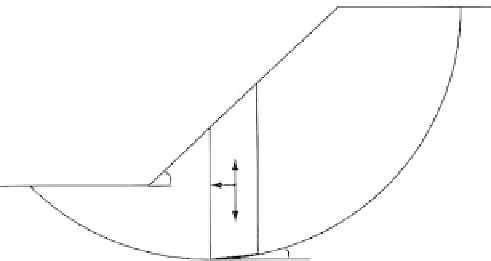Environmental Engineering Reference
In-Depth Information
Representative samples of the embankment and foundation soils are subjected to labo-
ratory testing under combinations of preearthquake stress conditions and superimposed
dynamic stresses to permit assessments of the influence of earthquake-induced stresses on
the potential for liquefaction and deformations. From the data, the overall deformations
and stability of the dam sections are analyzed.
Pseudostatic Analysis
(see also
Section 9.3.2)
In the conventional approach, the stability of the potential sliding mass is determined for
static loading conditions and the effects of an earthquake are accounted for by including
equivalent vertical and horizontal forces acting on the mass. The horizontal and vertical
effects of pore pressure are not considered, and a decrease in soil strength is accounted for
only indirectly.
Various applications of the coefficient
k
can be found in the literature. It seems reasonable
to decrease the resisting force by adding the term
k
v
W
, or considering that the vertical accel-
eration of gravity is less than the horizontal aceleration, 0.67
k
v
W
; and to increase the driv-
ing force by adding the term
W
(
k
h
cos
θ
) to Janbu's equation (Equation 9.17) as follows:
FS
f
o
(
∑
{[
c
'
b
(
W
0.67
k
v
W
ub
) tan
φ
'] [1/cos
θ
M
i
(
θ
)]}/
∑
W
(tan
θ
k
h
cos
θ
)
V
)
(11.22)
) is given in Equation 9.18, and
f
o
in Equation 9.19.
The selection of the seismic coefficient is empirical. After a review of various investiga-
tors, it is suggested that the values given in Table 11.12 are considered reasonable.
Where cos
θ
M
i
(
θ
Earthquake Behavior Analysis of Earth Dams
Pseudostatic analysis is now generally recognized as being inadequate to predict earth dam
behavior during earthquakes. The Committee on Earthquakes of the International
Slice
n
F
v
0
F
h
c
,
i
FIGURE 11.38
Pseudostatic seismic forces acting on a
slice in Janbu Method.
W
b
TABLE 11.12
Seismic Coefficient
K (
Suggested Values)
K
Zone
Intensity I
0.0
0
I-IV
0.05
1
V-VI
0.10
2
VII
0.15
3
VIII-IX
0.25
3
X or greater
0.50
3
VIII or greater and high risk




